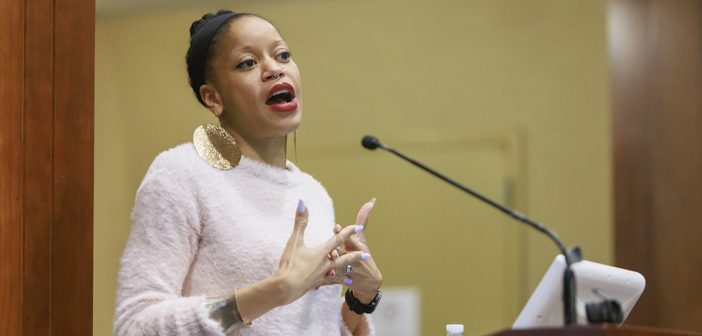Khiara M. Bridges, Ph.D., a leading scholar on critical race theory, reviewed the state of racial bias in American law and society at a Department of African and African American Studies Lecture on Feb. 23.
In her talk, “Critical Race Theory: An Introduction,” Bridges presented the history of the academic concept that has been in the news recently and addressed the misinformation circling the topic.
Critical race theory (CRT) began in the 1970s when scholars reflected on the state of Black Americans after the Civil Rights Movement, said Bridges, a law professor at the UC Berkeley, where she specializes in race and gender in the law. Civil rights law abolished discrimination, racial segregation, and disenfranchisement, yet the Black community was at the bottom of social well-being. The resulting intellectual movement, she said, designated racism as systemic and embedded in America’s legal policies and systems.
Today, she said, the term is misunderstood and misused.
“Critical race theory has become a floating signifier and has expanded to refer to any progressive thought about race,” said Bridges, who published Critical Race Theory: A Primer (Concepts and Insights) in 2019. “This means that all progressive thought about race is at risk of being censored. I may not even be able to give today’s lecture in a couple of years. While I can still talk about it, let me take advantage of this.”
Critical Race Theory in the News
After the social reckoning that resulted from George Floyd and Breonna Taylor’s deaths in the summer of 2020, Bridges said, CRT became caught in the crosshairs of conservative activists, led by Christopher F. Rufo of the conservative Manhattan Institute think tank. He claimed that the federal government was teaching CRT to its employees. After Rufo appeared on Fox News, the Trump administration tapped him to co-write an executive order prohibiting training funded with federal money that is “rooted in the pernicious and false belief that America is an irredeemably racist and sexist country,” Bridges said, quoting the order.
Bridges also talked about CRT being banned in Florida schools, as well as the College Board recently removing CRT, along with Black feminism, Black queer thoughts and theory, and the Black Lives Matter social movement, from the curriculum of AP classes.
Bridges described CRT as an intellectual movement—a body of scholarship and an analytical tool set for examining how law and racial inequality are interconnected.
“Unfortunately, critical race theory has become a term that references not a distinct legal literature, but rather a brand category that is intended to capture everything that is unpopular with Americans,” said Bridges.
Sophia Henderson, a senior majoring in Film & Television and New Media & Digital Design who attended the lecture, said that point made an impact on her.
“It really hit home for me when Bridges connected critical race theory to brand category and how conservatives changed CRT’s definition,” she said. “I could see how changing the definition is possible and how powerfully it can affect the public’s perception.”
Analyzing Racist Acts through a CRT Lens
Bridges went on to discuss the differences between racism and CRT. On the screen flashed pictures of George Floyd and Eric Garner, two Black men who were killed by police officers.
Under the CRT lens, aside from asking whether those officers acted out of racism, more questions need to be asked, she said. What led these Black men to commit non-violent, white-collar crimes? Floyd allegedly tried to use a counterfeit 20-dollar bill at a convenience store, and Garner was suspected of selling loose cigarettes. What circumstances did these two men face that it made sense for them to do these things? Why did they have the health issues they had—heart problems for Floyd and asthma for Garner?
The traditional definition of racism would look at the bad actors, in this case, the officers, and assume that once they are removed from their positions, everything would be solved, she said. But under CRT’s lens, more structural changes would be needed–like providing financial opportunities and a safety net for people of color, analyzing their environments and making their neighborhoods more healthy, and even providing nutritious food and other interventions to counteract systemic racism.
Tyesha Maddox, an assistant professor at the Department of African and African American Studies and the event’s organizer, said the lecture solidified her ideas “of exactly what critical race theory is in a very simple way.” Maddox first learned about Bridges on Instagram and knew that she would be the right speaker to tackle the topic for the Black History Month event. “It will make it easy for me to explain to my students, and even family members, what critical race theory is today,” Maddox said.
Reclaiming CRT: The Stakes Are High
CRT has existed over the past 40 years but has been a target of conservative activists since they “discovered” it in 2020, Bridges said. She shared that she thinks conservative activists will move on to the next “boogeyman” if this doesn’t win them an election. Until then, she said, they will still claim the term and society will have to wait to reclaim CRT in its correct form.
“The fight against CRT is truly the fight of our lives,” said Bridges. “The stakes are so incredibly high.”
Written by: Bernadette Young



